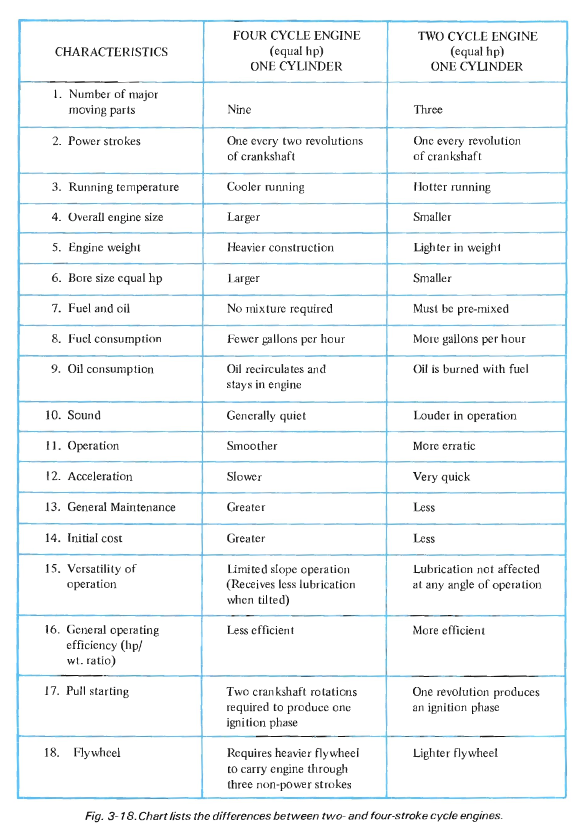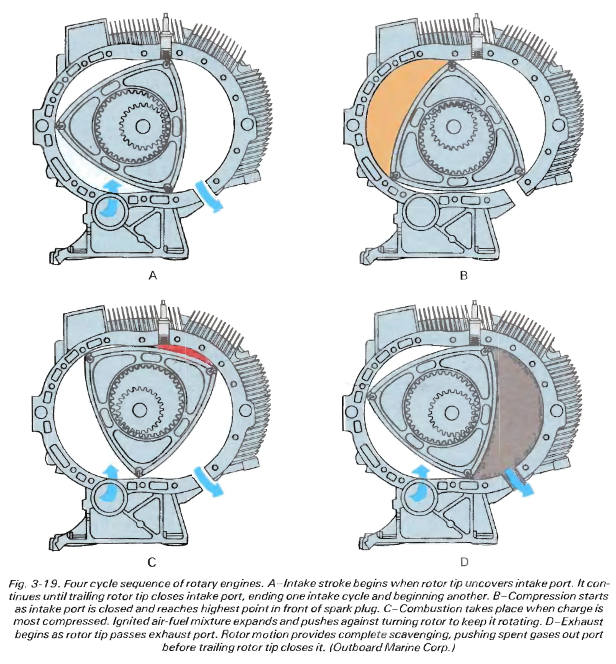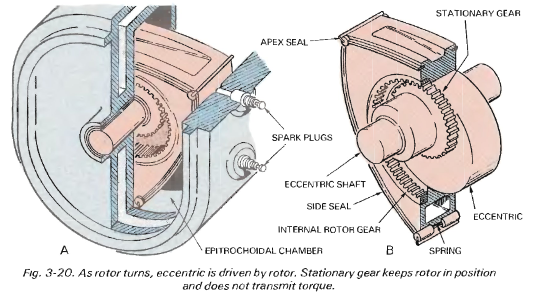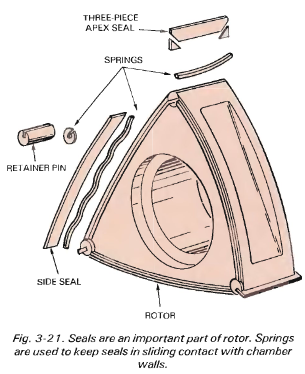| Type | Book |
|---|---|
| Date | 1992 |
| Pages | 352 |
| Tags | nonfiction |
Small Gas Engines
- 1: Safety in the Small Gas Engine Shop
- 2: Engine Construction and Principles of Operation
- 3: Two Cycle, Four Cycle, and Rotary Engines
- 4: Fuel Systems
- 5: Carburetion
- 6: Ignition Systems
- 7: Engine Lubrication
- 8: Engine Cooling
- 9: Measuring Engine Performance
- 10: Tools and Measuring Instruments
- 11: Troubleshooting, Service, and Maintenance
- 12: Fuel System Service
- 13: Ignition System Service
- 14: Cylinder Reconditioning
- 15: Pistons and Piston Rings
- 16: Rods, Bearings, and Valves
- 17: Small Gas Engine Applications
- 18: Career Opportunities
- Useful Information
- Dictionary of Terms
1: Safety in the Small Gas Engine Shop
2: Engine Construction and Principles of Operation
In a four-cycle engine, the camshaft gear is always twice as large as the crankshaft gear.
3: Two Cycle, Four Cycle, and Rotary Engines
Four-stroke cycle engines
A four-stroke cycle or four cycle engine uses four strokes for each cycle: intake, compression, power, and exhaust. Two strokes occur during each revolution of the crankshaft.
During the intake stroke, the piston draws the fuel-air mixture into the cylinder. The intake valve is open.
During the compression stroke, the valves are closed, and the air-fuel mixture is compressed into a small space. This compression heats the gaseous mixture to near its flash point, causing total combustion to occur nearly instantaneously.
During the power stroke, the valves are closed. The fuel mixture is ignited and the expanding gases force the piston down. Typically, the spark that ignites the fuel is timed to occur just before the piston reaches top dead center (TDC) on the compression stroke, in order for the fuel mix to have time to ignite.
During the exhaust stroke, the exhaust valve is open, and the piston forces the exhaust gases out of the cylinder. This is called scavenging. The gases flow out through a passageway called the exhaust manifold or exhaust port. The exhaust valve temperature may range from 1200°F to 2500°F.
The two main systems for lubricating a four cycle engine are the splash system and the pump system. Engines may employ a combination of the two.
In a splash system, a splash finger may be dipped into the oil reservoir in the crank case, and then throw the oil onto other components.
In a pump system, an oil pump draws in oil and sprays it onto components, or forces it through a filter.
If a four cycle engine is operated at extreme angles, the oil will flow away from the pump or splash finger, causing the engine to lose lubrication.
Two-stroke cycle engines
In a two cycle engine, all four stages (intake, compression, power, and exhaust) occur during a single revolution of the crankshaft.
Compared to a four cycle engine of comparable horsepower, a two cycle engine will be smaller, lighter, and simpler in design.
A two cycle engine can be operated at extreme angles without a lubrication failure, because it is lubricated by oil mixed into the fuel.
Two basic types of two cycle engines are in general use: cross-scavenged and loop-scavenged.
A cross-scavenged engine has a specially shaped piston head that directs the incoming fuel-air mixture toward the spark plug and away from the exhaust port, since both are open simultaneously. The piston itself acts as a valve, in this design.
A loop-scavenged engine has transfer ports shaped to the incoming fuel mixture swirls, helping to force exhaust gases out.
As the piston moves upward, crankcase pressure drops and the intake port is exposed, allow air to be forced through the carburetor by atmospheric pressure to equalize the crankcase pressure.
As the piston moves downward, the fuel-air mix in the crankcase is compressed, so that when the transfer port is exposed, this mixture is forced into the cylinder, which simultaneously forces the exhaust gases out.
The compression ratio (which is less than the pressure ratio) of a two cycle engine will be about 10:1. Once compressed, as in a four cycle engine, the fuel is ignited to force the piston down. In some engines, spark will occur nearly at TDC during starting, and during runtime spark timing will automatically advance to improve efficiency.
Most exhaust gases are expelled before intake occurs, with the remainder expelled when the transfer ports open.
For best efficiency, the fuel charge should be held in the cylinder momentarily while the exhaust port is open. This helps prevent fuel from being drawn out of the cylinder with exhaust gases.
The exhaust may be designed so that the sound waves from the exhaust create pressure, preventing the fuel-air mixture from escaping. The pipe may be angled like a megaphone to concentrate the sound waves. Too long an exhaust pipe will prevent this from working.
A reed valve is a thin piece of spring steel which covers a port. It is fixed on one end, and the other may be opened by pressure from the port. A reed stop, made of heavy, inflexible steel, prevents the reed from bending too far. A reed valve engine uses such a valve to allow fuel intake into the crankcase during the intake stroke.
Rotary engines
The Wankel rotary engine, invented by Dr. Felix Heinrich Wankel, has far far fewer moving parts than a reciprocating engine:
The rotary is much lighter and has only a very few moving parts. A six-cylinder automotive piston engine has over 230 basic parts, 166 of them moving. A two-rotor Wankel has about 70; only three move.
The rotary engine has the familiar four-stroke cycle, but the four strokes are completed three times per revolution of a rotor, and the shaft driven by the rotor similarly revolves three times for each revolution of the rotor. Each rotor effectively acts as three cylinders.
The major difficulty with early rotary engines was wear on the apex seals.
Rotary engines do not require periodic oil changes, merely that oil be added to replace that lost during operation.
Research
If rotary engines are so great, why don't we use them more often?
Answer: there are inefficiencies with the design at high speeds, or when speed isn't constant, leading to poor fuel efficiency. Due to the shape of the epitrochoidal chamber (very long and thin) and the motion of the rotor, it is difficult for the fuel to fully combust, and for the power of combustion to be usefully transmitted.
4: Fuel Systems
5: Carburetion
6: Ignition Systems
85-110
7: Engine Lubrication
111-126
8: Engine Cooling
127-136
9: Measuring Engine Performance
137-154
10: Tools and Measuring Instruments
155-176
11: Troubleshooting, Service, and Maintenance
177-190
12: Fuel System Service
191-212
13: Ignition System Service
213-242
14: Cylinder Reconditioning
243-252
15: Pistons and Piston Rings
253-268
16: Rods, Bearings, and Valves
269-296
17: Small Gas Engine Applications
297-322
18: Career Opportunities
323-326
Useful Information
327-336
Dictionary of Terms
337-345
| Name | Role |
|---|---|
| Alfred C. Roth | Author |
| Ronald J. Baird | Author |
| The Goodheart-Willcox Company, Inc. | Publisher |



